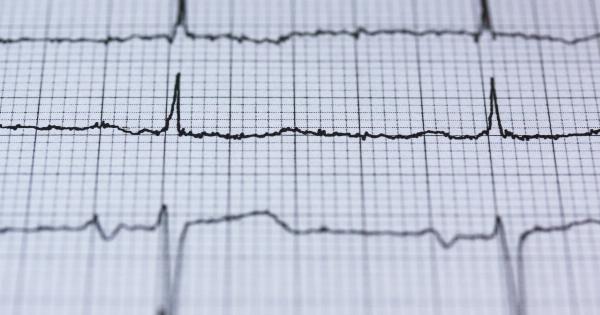Cardiovascular diseases have become one of the leading causes of death around the world. Some of these diseases are hereditary, which means they are passed down from parents to their offspring through genetic inheritance.
With the advancements in gene testing, it is now possible to identify these hereditary cardiovascular diseases and take the necessary measures to prevent and treat them.
What is gene testing?
Gene testing, also known as genetic testing, is the process of analyzing an individual’s DNA to identify genetic variations and mutations that may contribute to certain diseases.
This can be done through a variety of methods, including blood tests, saliva samples, and cheek swabs.
Types of hereditary cardiovascular diseases identified with gene testing
Here are the 20 hereditary cardiovascular diseases that can be identified with gene testing:.
1. Hypertrophic cardiomyopathy (HCM)
HCM is a disease in which the heart muscle becomes abnormally thick, making it harder for the heart to pump blood. It is caused by mutations in genes that control heart muscle growth.
2. Dilated cardiomyopathy (DCM)
DCM is a condition in which the heart becomes enlarged and weakened, leading to heart failure. It is caused by variations in genes that control heart muscle function.
3. Arrhythmogenic right ventricular dysplasia (ARVD)
ARVD is a rare but potentially life-threatening condition in which the heart muscle is replaced by fatty or fibrous tissue. It is caused by mutations in genes that control cell adhesion and desmosome function.
4. Familial hypercholesterolemia (FH)
FH is a genetic disorder that causes very high levels of low-density lipoprotein (LDL) cholesterol in the blood, leading to an increased risk of heart disease and stroke. It is caused by mutations in genes that control LDL cholesterol metabolism.
5. Long QT syndrome (LQTS)
LQTS is a condition in which the heart takes longer than normal to recharge between beats, leading to an increased risk of sudden cardiac arrest. It is caused by mutations in genes that control ion channels in the heart.
6. Brugada syndrome
Brugada syndrome is a rare but potentially life-threatening condition in which the heart’s electrical activity is disrupted, leading to an increased risk of sudden cardiac death.
It is caused by mutations in genes that control ion channels in the heart.
7. Catecholaminergic polymorphic ventricular tachycardia (CPVT)
CPVT is a rare but potentially life-threatening condition in which the heart’s electrical activity is disrupted by stress or exercise, leading to an increased risk of sudden cardiac death.
It is caused by mutations in genes that control the release of calcium in the heart cells.
8. Marfan syndrome
Marfan syndrome is a genetic disorder that affects the body’s connective tissue, leading to a range of symptoms including heart problems such as aortic aneurysm and dissection.
It is caused by mutations in genes that control the production and function of fibrillin, a protein found in connective tissue.
9. Ehlers-Danlos syndrome (EDS)
EDS is a genetic disorder that affects the body’s connective tissue, leading to a range of symptoms including heart problems such as aortic aneurysm and dissection.
It is caused by mutations in genes that control the production and function of collagen, a protein found in connective tissue.
10. Alpha-galactosidase A deficiency (Fabry disease)
Fabry disease is a rare but potentially life-threatening condition in which a buildup of a certain type of fat in the body can cause damage to the heart, kidneys, and other organs.
It is caused by mutations in genes that control the production and function of an enzyme called alpha-galactosidase A.
11. Danon disease
Danon disease is a rare but potentially life-threatening condition in which a buildup of a certain type of fat in the body can cause damage to the heart and other organs.
It is caused by mutations in genes that control the production and function of a protein called lysosome-associated membrane protein 2 (LAMP2).
12. Noonan syndrome
Noonan syndrome is a genetic disorder that affects several parts of the body, including the heart. It can cause a range of cardiac abnormalities, including hypertrophic cardiomyopathy (HCM).
It is caused by mutations in genes that control cell signaling pathways.
13. Leopard syndrome
Leopard syndrome is a genetic disorder that affects several parts of the body, including the heart. It can cause a range of cardiac abnormalities, including hypertrophic cardiomyopathy (HCM).
It is caused by mutations in genes that control cell signaling pathways.
14. Loeys-Dietz syndrome
Loeys-Dietz syndrome is a genetic disorder that affects several parts of the body, including the heart and blood vessels. It can cause a range of cardiac abnormalities, including aortic aneurysm and dissection.
It is caused by mutations in genes that control cell signaling pathways.
15. Williams-Beuren syndrome
Williams-Beuren syndrome is a genetic disorder that affects several parts of the body, including the heart. It can cause a range of cardiac abnormalities, including supravalvular aortic stenosis.
It is caused by deletions of a certain region of chromosome 7.
16. Alagille syndrome
Alagille syndrome is a genetic disorder that affects several parts of the body, including the heart and liver. It can cause a range of cardiac abnormalities, including pulmonary artery stenosis.
It is caused by mutations in genes that control cell signaling pathways.
17. Holt-Oram syndrome
Holt-Oram syndrome is a genetic disorder that affects several parts of the body, including the heart and upper limbs. It can cause a range of cardiac abnormalities, including atrial septal defect and ventricular septal defect.
It is caused by mutations in genes that control limb and heart development.
18. Noonan syndrome with multiple lentigines (NSML)
NSML is a genetic disorder that affects several parts of the body, including the heart and skin. It can cause a range of cardiac abnormalities, including hypertrophic cardiomyopathy (HCM).
It is caused by mutations in genes that control cell signaling pathways.
19. Hypoplastic left heart syndrome (HLHS)
HLHS is a rare but potentially life-threatening condition in which the left side of the heart does not develop properly. It can cause a range of cardiac abnormalities, including aortic stenosis and mitral valve abnormalities.
The specific genetic causes of HLHS are not yet well understood.
20. Tetralogy of Fallot
Tetralogy of Fallot is a congenital heart defect that causes a range of abnormalities, including a ventricular septal defect, an overriding aorta, pulmonary stenosis, and right ventricular hypertrophy.
It is caused by mutations in genes that control heart development.
Conclusion
If you have a family history of cardiovascular disease or have experienced any symptoms of heart problems, it is important to consider gene testing to identify any hereditary cardiovascular diseases that may be present.
By identifying these diseases early, you can take the necessary measures to prevent or treat them, and reduce your risk of heart attack, stroke, and other potentially life-threatening complications.



























